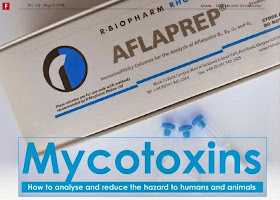Mycotoxins are a major hazard to humans and animals, often being found in a wide range of food and feed samples and causing cancer as a result of ingestion of contaminated commodities.
To reduce the risk, there is the need to control mycotoxins in certain types of susceptible cereals and foods. Mycotoxin analysis through the use of immunoaffinity column clean-up prior to HPLC is the worldwide method of choice.
These methods have been validated by inter-laboratory studies, in many cases using immunoaffinity columns supplied by R-Biopharm Rhône Ltd. They have been shown to improve analysis, enable laboratories to meet legislation and to ensure a safe and wholesome food supply.
Mycotoxins in general
As human life expectancy contuinues to rise, this results in more disease and the discovery of different types of cancer. In many cases, naturally occurring constituents have been found to be the source of the disease. Mycotoxins have not only been shown to cause cancer, but alsonephritis, hepatic diseases, various hemorrhagic syndromes, and immune and neurological disorders.
Mycotoxins are toxic secondary metabolites produced by moulds on food and feed products. Currently, at least 200 species have been identified and have been shown to produce more than 100 different mycotoxins.
The most common and toxic mycotoxins are aflatoxins, ochratoxin, zearalenone, deoxynivalenol, fumonisins, citrinin, patulin, T-2 and HT-2, which are produced by Aspergillus, Fusarium and Penicillium strains. Different mycotoxins can be produced by the same fungus. Hence different mycotoxins can appear in one commodity.
Aflatoxins are produced by the Aspergillus strain, which is found in tropical regions and affects various nuts, maize, dried fruits and spices. Ochratoxin is found in cold temperatures but affects similar commodities to aflatoxins and can be produced by Aspergillus and Penicillium strains. Zearalenone, deoxynivalenol, fumonisins, citrinin, T-2 and HT-2 are Fusarium toxins and mostly appear in cereals.
Whereas patulin is limited to be found on soft fruits, fruit juices and purées.
Moulds can infect agricultural crops during crop growth, harvest, storage or processing. The growth of the mould is not necessarily related to the formation of mycotoxins and the stability of the toxin means that they may be present in food when the fungi are no longer present. Mycotoxins are produced depending on the conditions such as humidity, moisture, temperature and rainfall. Another route can be during harvest or transportation by using the same equipment or trucks to handle or transport different food and feed commodities, such as crops, fruits and spices.
Read more HERE.
To reduce the risk, there is the need to control mycotoxins in certain types of susceptible cereals and foods. Mycotoxin analysis through the use of immunoaffinity column clean-up prior to HPLC is the worldwide method of choice.
These methods have been validated by inter-laboratory studies, in many cases using immunoaffinity columns supplied by R-Biopharm Rhône Ltd. They have been shown to improve analysis, enable laboratories to meet legislation and to ensure a safe and wholesome food supply.
Mycotoxins in general
As human life expectancy contuinues to rise, this results in more disease and the discovery of different types of cancer. In many cases, naturally occurring constituents have been found to be the source of the disease. Mycotoxins have not only been shown to cause cancer, but alsonephritis, hepatic diseases, various hemorrhagic syndromes, and immune and neurological disorders.
Mycotoxins are toxic secondary metabolites produced by moulds on food and feed products. Currently, at least 200 species have been identified and have been shown to produce more than 100 different mycotoxins.
The most common and toxic mycotoxins are aflatoxins, ochratoxin, zearalenone, deoxynivalenol, fumonisins, citrinin, patulin, T-2 and HT-2, which are produced by Aspergillus, Fusarium and Penicillium strains. Different mycotoxins can be produced by the same fungus. Hence different mycotoxins can appear in one commodity.
Aflatoxins are produced by the Aspergillus strain, which is found in tropical regions and affects various nuts, maize, dried fruits and spices. Ochratoxin is found in cold temperatures but affects similar commodities to aflatoxins and can be produced by Aspergillus and Penicillium strains. Zearalenone, deoxynivalenol, fumonisins, citrinin, T-2 and HT-2 are Fusarium toxins and mostly appear in cereals.
Whereas patulin is limited to be found on soft fruits, fruit juices and purées.
Moulds can infect agricultural crops during crop growth, harvest, storage or processing. The growth of the mould is not necessarily related to the formation of mycotoxins and the stability of the toxin means that they may be present in food when the fungi are no longer present. Mycotoxins are produced depending on the conditions such as humidity, moisture, temperature and rainfall. Another route can be during harvest or transportation by using the same equipment or trucks to handle or transport different food and feed commodities, such as crops, fruits and spices.
Read more HERE.
The Global Miller
This blog is maintained by The Global Miller staff and is supported by the magazine GFMT
which is published by Perendale Publishers Limited.
For additional daily news from milling around the world: global-milling.com


No comments:
Post a Comment